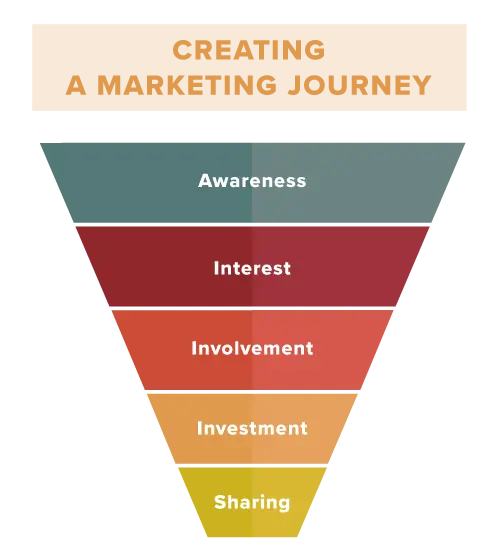There are likely a variety of ways for a new contact to discover and interact with your organization on their way to becoming a super supporter. Nonprofit marketing funnels help clarify those journeys, allowing you to focus on strategies that move them to complete your most important goals.
How much time and thought have you put into streamlining that path and making the journey easier on people like your ambassadors, donors and volunteers? What would you like their path to look like, ideally? How can you help to get them on that path and keep them moving through it without losing too many strays?
Let’s talk about supporter journeys and nonprofit marketing funnels—every unicorn’s favorite topic. I’ll walk through the process of finalizing your nonprofit’s ideal supporter funnel, as well as how you can use that funnel to improve your marketing.
Questions to Answer
Before we can dive into building out the perfect funnel for your supporters to follow, you’ll need to gather as much information as you can about your audience and current communications and interactions with them.
Start with these questions to better understand your audience and current marketing process:
- Do you have audience personas? Consider creating (and using) target audience personas.
- What are the typical touchpoints and communications that your organization has with members of your audience? This should include all stages of supporters, from people just learning you exist to your most die-hard major donors.
- How do new supporters usually learn about your organization? What other ways might they learn about you?
- After a top-of-the-funnel action, such as signing up for your newsletter, what follow-up communications do you have in place?
- How do they become aware of more opportunities, like donating, volunteering or attending events?
- How can they reach out to your organization? Who could they talk to if they do?
- What factors might affect whether someone completes your goals? For example, your cause was recently in the news, which prompted more people to reach out. Or maybe you launched a new website, making your donation process easier to complete online.
- What could be preventing a supporter from increasing their involvement with your organization? For example, volunteer sign-ups and donations take visitors to a different website that they may not immediately trust. Or maybe your website content has not been updated and contains out-of-date information.
If you’re not sure about all of these questions now, you might think about how you can obtain that information to improve and hone your funnel and subsequent marketing strategies moving forward. Consider these ideas:
- Set up Google Analytics dashboards for easy access to website data
- Conduct an analytics review
- Send a supporter survey to ask donors, volunteers or email subscribers directly
- Ask for feedback on social media
And whenever you learn something new, record it in the documentation of your personas or nonprofit marketing funnels. You’ll thank yourself for the updated information when you return to these funnels again and again.
Marketing Journeys
There are likely an infinite number of specific journeys that your audience can travel through as they learn more about what you do and get more involved with your organization. Claire Axelrad outlined the donor funnel for Guidestar as the following: Awareness > Interest > Involvement > Investment > Sharing.

Your supporters’ journeys may differ from this standard one in terms of what brings people to the next stage, but it helps to reference something commonplace across a wide variety of nonprofits. Use it as a nice guideline to follow as you learn more about how supporters come to know you and customize their individual journeys.
Awareness
In the awareness stage, supporters are just learning about your organization, coming to you from a variety of sources, like social media, search engines, friends, partner organizations, etc.
To move onto the next stage of the funnel, they’ll need to take an action that shows their interest in your cause or mission. This could be signing up for your email newsletter, following you on Twitter or interacting with a post on Facebook.
Interest
They know who you are and they are interested in your cause, learning a bit about who you are and what you do by this point.
To get them to move through to the next stage, they’ll need to get involved with your organization. That could mean attending a community event, signing a petition or reaching out about one of your programs.
Involvement
They have participated in one of your initiatives, yes, but they are still a bit wishy-washy compared to your super supporters.
To move onto the next stage, they will need to become a donor and/or volunteer.
Investment
This investment could be time, as in a volunteer, or money, as in a donor. Or both! Once they’ve made that initial investment, the funnel is not over. It takes time and nurturing to either keep them here or move them onto the next level: your super supporters.
To move from here onto the next level, the supporter needs to shout your praises and help to expand your audience and bring in new supporters.
Sharing
Your ambassadors are here at the very bottom of the funnel. They can help you bring in a whole new audience to the top of your funnel. Keep your retention efforts in peak form to make sure these folks stick around and know their efforts are appreciated.
Mapping Out Nonprofit Marketing Funnels
Take the research on your audience and your interactions with them, identifying key actions that move a supporter from one stage to the next. Look for:
- What actions fit within each stage of the funnel?
- How can you measure each of those actions?
- What improvements can you realistically pursue in terms of those actions?
- Which of those will have the most meaningful results for your organization?
- How can you better move people toward those actions?
Your nonprofit marketing funnels don’t need to include every possible action and journey that a supporter could possibly take, but rather a typical path that occurs frequently and is grounded in key actions that move them closer to becoming a die-hard, lifelong supporter.
Using Your Funnels
Mapping out nonprofit marketing funnels is not of much use in and of itself. The benefits flood in when you start using all of the insights you discover about supporter journeys to improve your messaging and focus in on key goals that move people forward on their journey to a strong and lasting relationship with your nonprofit.
Build Relationships
Use your funnels to improve your relationship building through your marketing and communications efforts. Put yourself in your supporters’ shoes, make an effort to learn what they care about and listen when they offer feedback, however that may be.
Develop New Marketing Goals
Did you discover key actions within your funnel that are not represented as current marketing goals? If an action is important enough to move someone to the next stage of your nonprofit marketing funnels, develop a goal around the action to ensure that you’re consistently working to move people through.
Adjust Your Strategy
Now that you know how you’d like people to move toward your most important goals, you can adjust your nonprofit marketing strategy accordingly.
What do your nonprofit marketing funnels look like? Do you use them to set goals for your marketing plan? Any hang-ups on trying it out? Let’s talk in the comments.
What You Should Do Now
01. Come to Nonprofit Website Office Hours
We cover a new topic every few weeks. Plus get a live answer to any website-related question you're wrestling with.
02. Book a Website Call
Find a time to discuss your nonprofit's website needs. Discover what's worked for other nonprofits like you and see how easy building your new site can be.
03. Start a Free Website Trial
Try our nonprofit website platform for yourself. Instantly get access to every feature to see if it's the right fit for your needs. No credit card required.

Comments